Cascadia Research will be undertaking a 15-day field project based off the island of Lāna‘i starting December 7th, 2012. This will be our first time working back in the “4-island” area since 2003, and our first-ever field project based off the island of Lāna‘i. The primary purpose of the project is to obtain information on movements and diving behavior of false killer whales, through the deployment of LIMPET satellite tags. The main Hawaiian Islands insular population of false killer whales has been listed as Endangered under the U.S. Endangered Species Act, and we are hoping to collect information that will help define critical habitat and assess population trends. We will also be trying to deploy satellite tags on several other species to examine movements and habitat use, including short-finned pilot whales and bottlenose dolphins, to help define population boundaries within the islands. Like all of our projects we’ll also be obtaining photos from most species of odontocetes we encounter, to contribute to ongoing studies of residency patterns and social organization and to estimate population sizes, and collecting biopsy samples for toxicology and genetic studies.
The research team includes Daniel Webster, Annie Douglas, Katy Laveck and Robin Baird of Cascadia, as well as visiting researchers from the Pacific Islands Fisheries Science Center. This work is primarily being funded by a grant from the Pacific Islands Fisheries Science Center with support from Dolphin Quest and the Commander, Pacific Fleet (US Navy).
End of project update
December 21st was the last day of our field project. Over the 15 days we encountered 8 species of cetaceans, and had 34 encounters with 6 species of odontocetes, including 11 sightings of pantropical spotted dolphins, 8 sightings of short-finned pilot whales, 7 sightings of bottlenose dolphins, 6 sightings of spinner dolphins, and single sightings of melon-headed whales and rough-toothed dolphins. We deployed 7 satellite tags (on 3 species), collected 23 biopsy samples (of 7 species), and took 16,011 photos (100 GB worth, good to go for an even number!). Despite the mostly sub-optimal weather, all-in-all a very productive trip. For photos and highlights of the trip see below.
December 18th
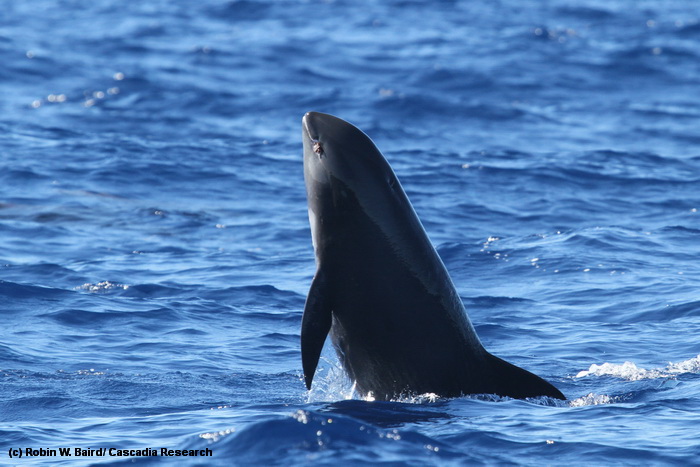
Melon-headed whale leaping, December 18, 2012. Photo (c) Robin W. Baird. After several days of marginal weather conditions, we finally had a day where we were able to survey in deep water west of Lāna‘i, and found a mixed group of melon-headed whales and rough-toothed dolphins. This was our first encounter of either species in the 4-island area – we were able to photo-identify more than 20 individual rough-toothed dolphins and ~100 melon-headed whales, as well as collecting six genetic samples (five from melon-headed whales, one rough-toothed dolphin), and deployed one satellite-tag on a melon-headed whale. A good day. This individual has some stalked barnacles, probably attached to teeth exposed from an injury on the left side of the jaw.
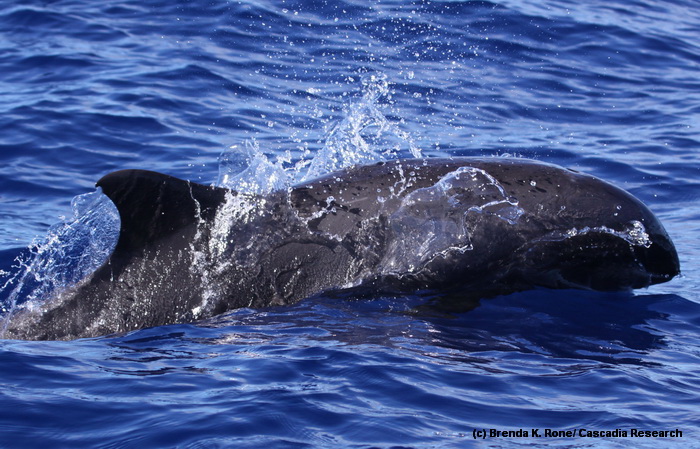
Melon-headed whale, December 18, 2012. Photo (c) Brenda K. Rone. There are two known populations of melon-headed whales in Hawai‘i, a small population resident to the northwest side of the Hawai‘i Island, and a larger population that moves among the islands and that ranges offshore. We suspect the group we encountered today is part of the “main Hawaiian Islands” population, but will be able to confirm this both with photo-identification and genetic analyses of biopsy samples. More information on melon-headed whales can be found on our web page on that species
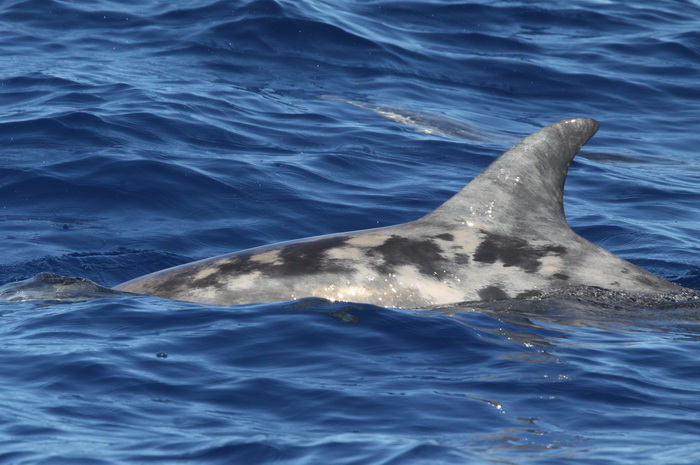
A piebald rough-toothed dolphin, December 18, 2012. Photo (c) Katy A. Laveck. The photos of rough-toothed dolphins obtained today will be compared to our catalog for this species – we have evidence of a small resident population off Hawai‘i Island and a larger population off Kaua‘i and Niihau, and photos from this area inbetween will be extremely valuable for assessing the ranges of both populations. For more information on rough-toothed dolphins see our web page for that species.

Rough-toothed dolphins, December 18, 2012. Photo (c) Brenda K. Rone
December 13th update
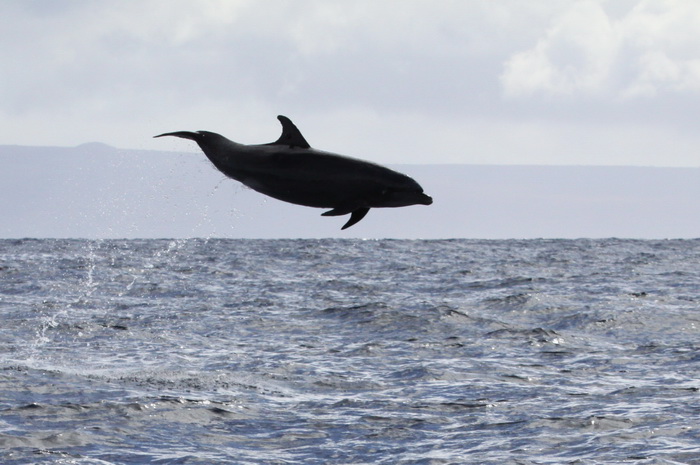
Common bottlenose dolphin leaping, December 13, 2012. Photo (c) Siri Hakala/Pacific Islands Fisheries Science Center. Today we tried to search in deep water to the west of the island but the strong winds prevented us from working offshore. We had a productive day nonetheless, with a good encounter with a group of about 18 bottlenose dolphins – we were able to photo-identify most of the individuals present, collect one biopsy sample, and deploy a location/dive satellite-tag on one individual. This is the 5th satellite tag we’ve deployed on a bottlenose dolphin in Hawai‘i and the second that records dive data – we are hoping to obtain movement and dive data from this individual over the next few weeks.
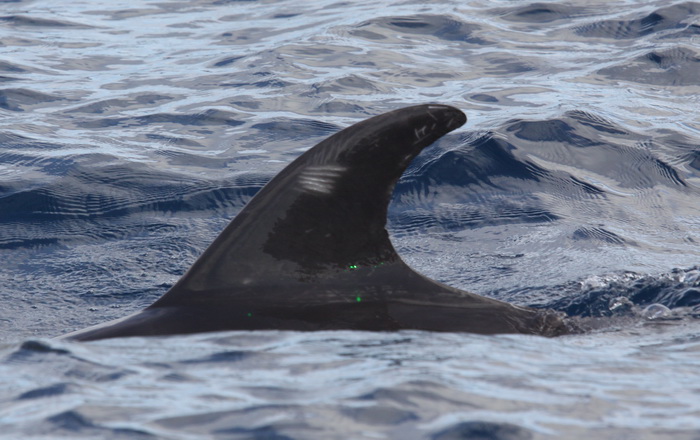
Common bottlenose dolphin with two green dots from a laser photogrammetry system below the dorsal fin, December 13, 2012. Photo (c) Katy A. Laveck. We are also using a laser photogrammetry system to measure the dorsal fins of several species of odontocetes, to be able to assess differences in dorsal fin size between the sexes (and with age). The two lasers are mounted 15 cm apart, thus can be used to measure the dorsal fin height and length at the base. In this photo there are also two close-together green reflections above the right-hand most of the two dots.
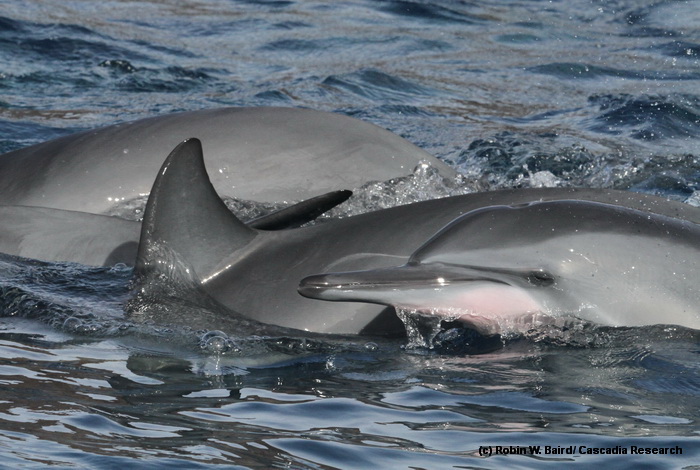
Spinner dolphins off the west side of Lāna‘i, December 13, 2012. Photo (c) Robin W. Baird. Since we weren’t able to work in deep water we spent some time looking for spinner dolphins along the west side of the island, and found a group of about 30 individuals. We were able to photo-identify most or all of the individuals present, and will send the photos to the Pacific Islands Fisheries Science Center for contribution to their catalog of this species.
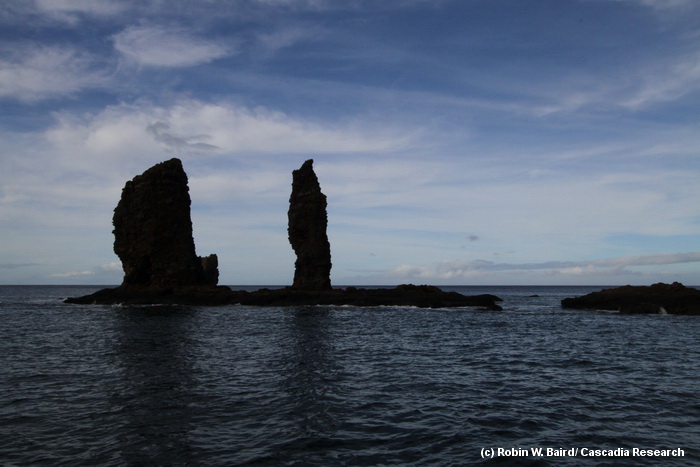
Sea stacks off the west side of Lāna‘i, December 13, 2012. Photo (c) Robin W. Baird
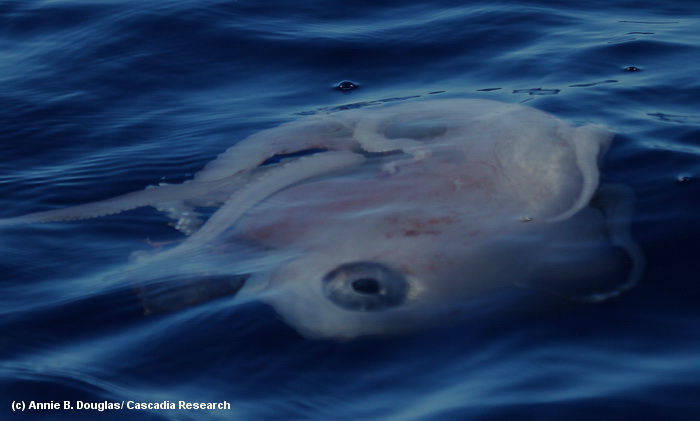
A pelagic octopod collected December 9, 2012. Photo (c) Annie B. Douglas. Since 2006 we have been collecting dead floating squid and fish that we find – on the 9th we collected our 105th specimen, a pelagic octopod that is probably Ocythoe tuberculata, also known as a Tuberculate Pelagic Octopus or Football Octopus. This specimen will go to Bill Walker at the National Marine Mammal Laboratory in Seattle for species confirmation, as well as collection of samples for stable isotopes and genetics.
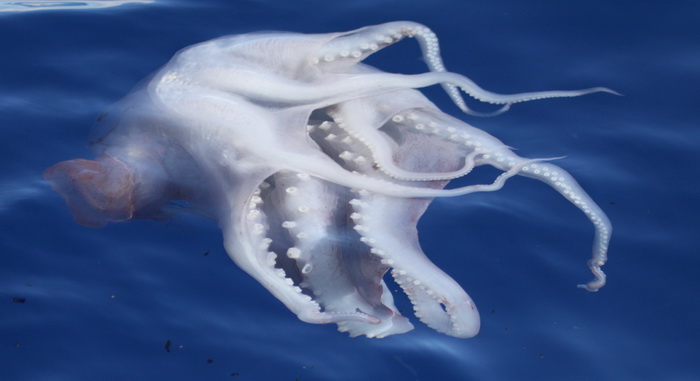
Another photo of the octopod collected December 9, 2012. Photo (c) Amanda L. Bradford
December 11th update
The last two days the forecast has increased to 25 knots and the sea conditions have deteriorated, making it impossible to work in the deep waters to the west and southwest of Lāna‘i. Instead we’ve been surveying in the waters between Lāna‘i and Maui, where we’ve encountered bottlenose dolphins, pantropical spotted dolphins, and a number of humpback whales.

Pantropical spotted dolphin, December 11th, 2012. Photo (c) Annie B. Douglas.
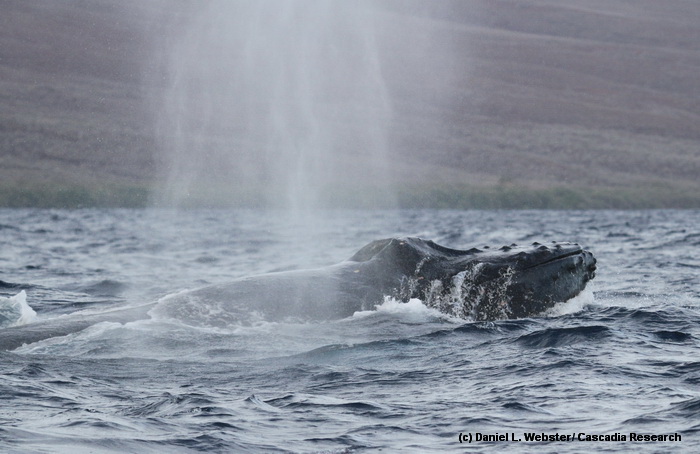
Humpback whale lunging, December 11th, 2012. Photo (c) Daniel L. Webster. Although normally we bypass humpback whales, today we encountered a group of three individuals that was accompanied by a single bottlenose dolphin, so we stayed with the group and photo-identified the dolphin, as well as one of the humpback whales. The group was a “surface-active” or “competitive” group, with two males apparently fighting over access to the female present.
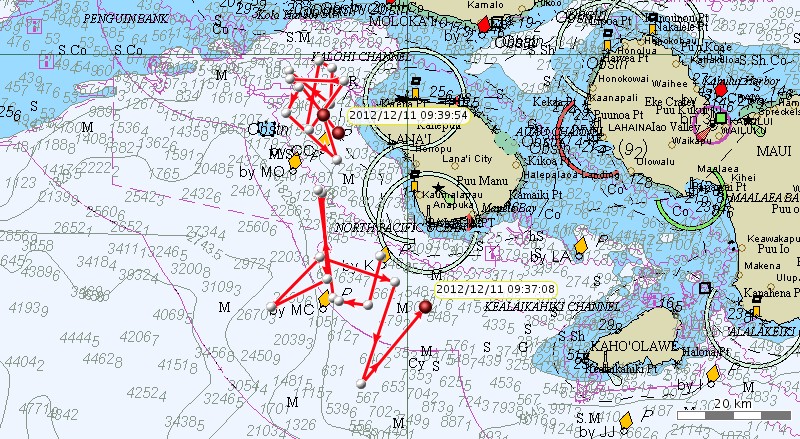
Map showing movements of the three satellite-tagged short-finned pilot whales over the last few days. Although we have not been able to get back into the deep water that pilot whales typically use, we are tracking the movements of the two groups that we’ve satellite-tagged – both are remaining in the deep water areas off the west side of the island.
December 9th update
Despite a forecast of 20 knots there was still a lee to the west of Lāna‘i, and we were able to make it out into over 2,000 m of water.
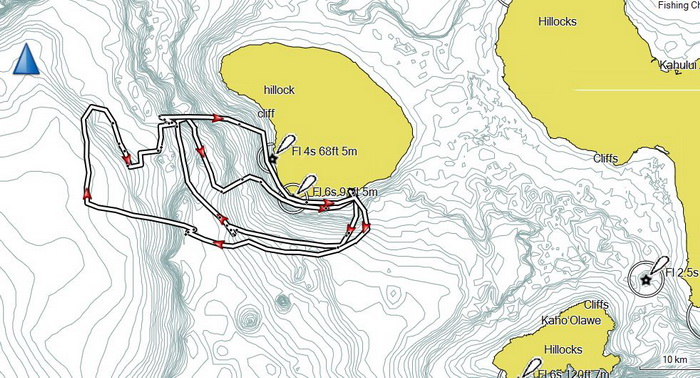
Tracklines for December 8th (inner line) and December 9th (outer line)
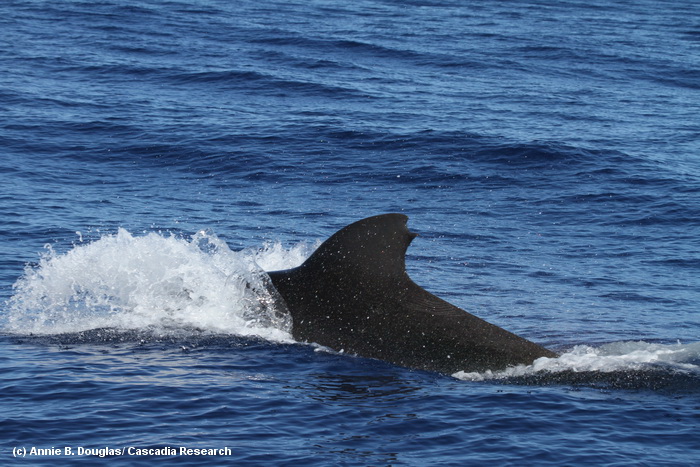
Normally pilot whales are one of the slower moving species we encounter, but today we found a group of fast moving individuals, and were able to follow them until they slowed. Photo (c) Annie B. Douglas. We were able to deploy satellite tags on two individuals in the group, and photo-identify most of the individuals present.

Adult male short-finned pilot whale, December 9th, 2012. Photo (c) Jonas P. Webster
December 8th update
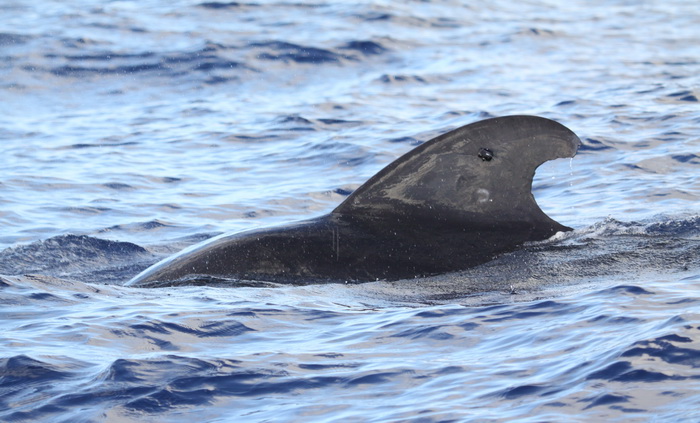
An adult male short-finned pilot whale with a satellite tag, December 8th, 2012. Photo (c) Katy Laveck. Although the weather today (winds of 10-15 knots) was not as good as yesterday, we had a productive day on the water, with an encounter with about 16 pilot whales, and were able to deploy a satellite tag on one individual to track movements of the group.
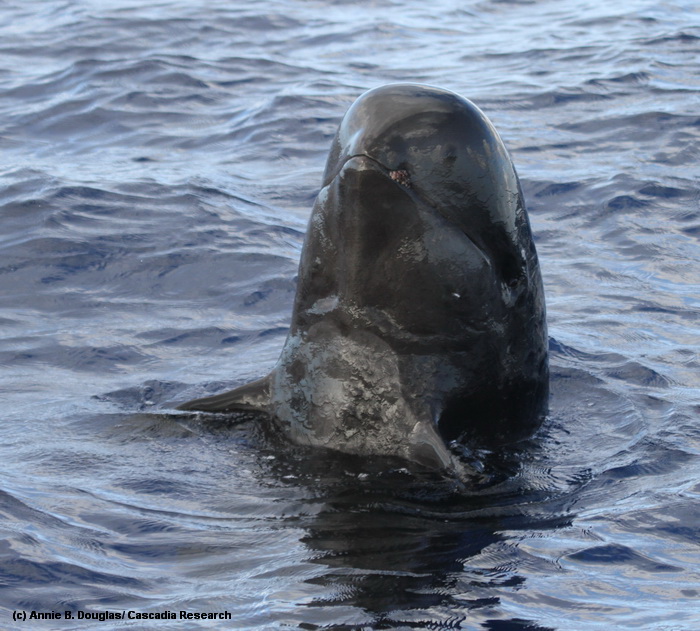
Short-finned pilot whale spyhopping, December 8th, 2012. Photo (c) Annie Douglas. We also photo-identified most of the individuals in the group, and were able to get spyhopping photos of two individuals – we take photos of spyhopping individuals to try to quantify mouth-line injuries, which may be indicative of fishery interactions.
December 7th update
Our first day on the water off Lāna‘i since May 2003 was quite productive, with six encounters with three species of odontocetes. The highlight of the day though was actually a baleen whale, our first-ever sighting of a fin whale in Hawaiian waters, in the 13 years of working here.
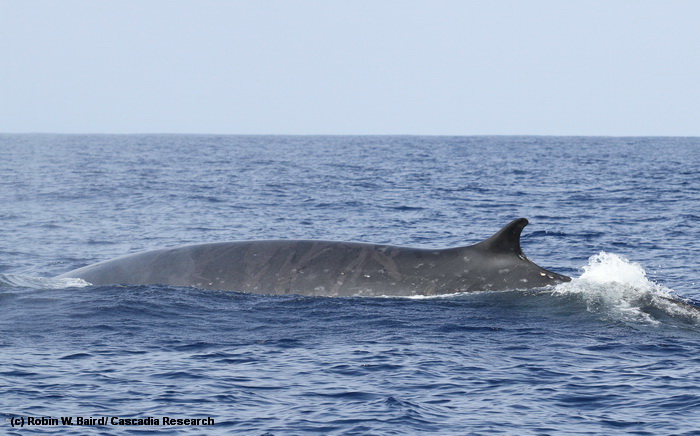
Fin whale off Lāna‘i, December 7, 2012. Photo (c) Robin W. Baird. We were able to obtain good identification photos, which will be compared with Cascadia’s photo-identification catalog of this species, and also a biopsy sample, which will be sent to the Southwest Fisheries Science Center for genetic studies.
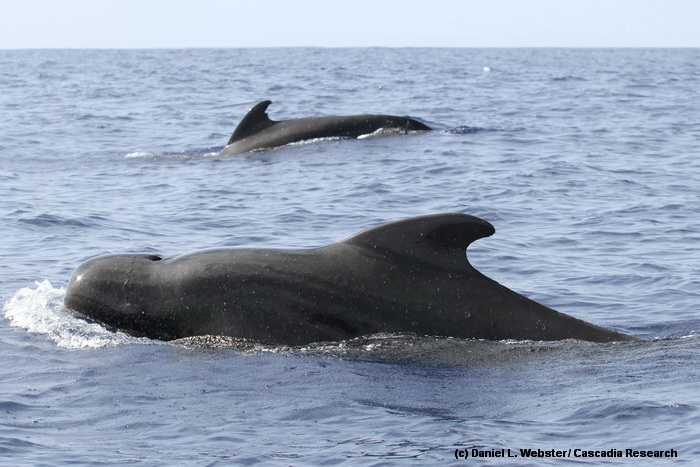
Short-finned pilot whales off Lāna‘i, December 7, 2012. Photo (c) Daniel L. Webster. We also have four different encounters with short-finned pilot whales, and were able to photo-identify more than 50 individuals.
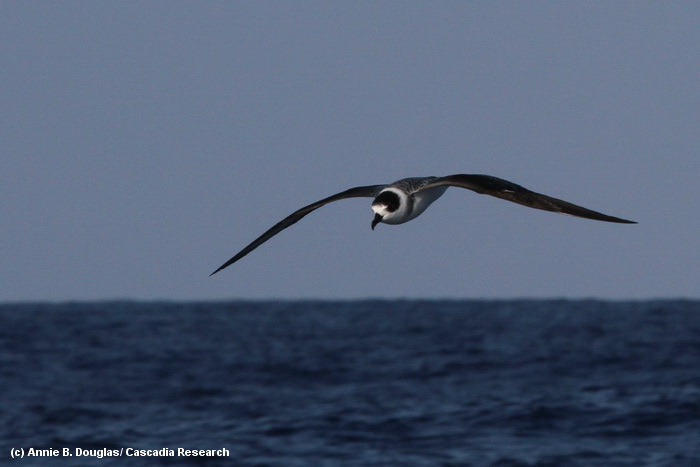
White-necked petrel off Lāna‘i, December 7, 2012. Photo (c) Annie B. Douglas
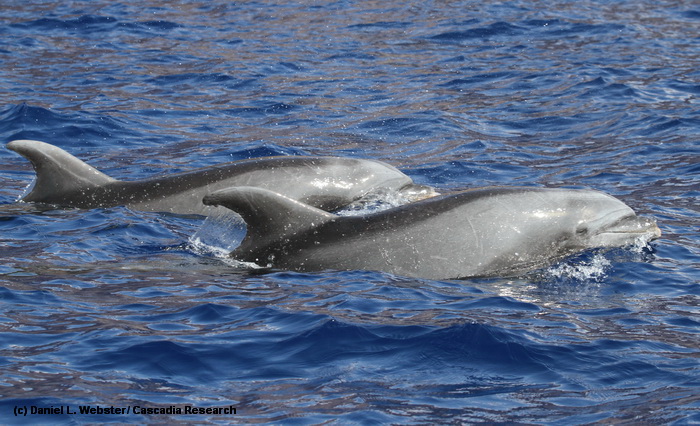
Bottlenose dolphins, December 7, 2012. Photo (c) Daniel L. Webster.
We previously worked in the 4-island area (based off Maui) in 2000, 2001, 2002, and 2003, and although we had not spent much time in the deep-water areas to the west of Lāna‘i, we have encountered pilot whales there fairly frequently. In 2010 we satellite tagged several short-finned pilot whales off O‘ahu and found they spent a lot of their time to the west and southwest of Lāna‘i (see map below).

A map showing movements of a short-finned pilot whale satellite tagged off O‘ahu in October 2010 (see report from that project). From tagging work off Kaua‘i, O‘ahu and Hawai‘i Island there is evidence of three separate island-associated populations of pilot whales within the main Hawaiian Islands, and we hope to obtain more data to assess movements among islands and help determine population boundaries.
From our work satellite tagging false killer whales elsewhere in the islands, we’ve also identified a high-density area for false killer whales to the southwest of Lāna‘i (see density map below), so we are hoping we may encounter this species one or more times.

A map showing density of false killer whales based on analysis of satellite-tag data – to see the full study download a copy of the paper published in Endangered Species Research in 2012.
Waters between Lāna‘i, Maui and Moloka‘i are quite shallow (typically <200 m deep), so we will be trying to spend most of our time in the deep water to the west and southwest of Lāna‘i, where we are more likely to encounter a wide range of species.

Sign up to our Facebook page if you want to receive notices of when information is posted and updates on other Cascadia projects.